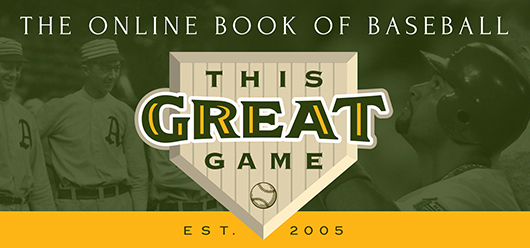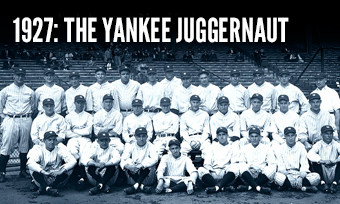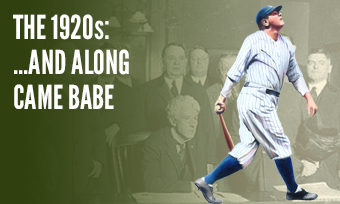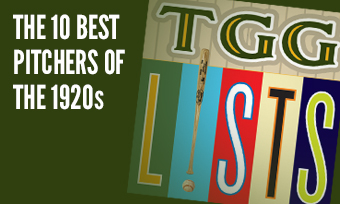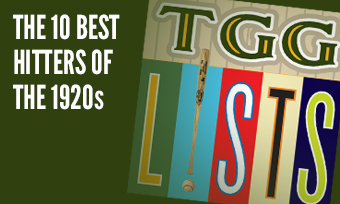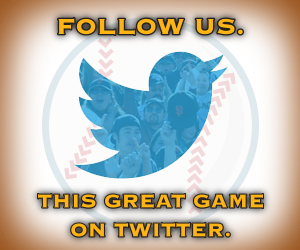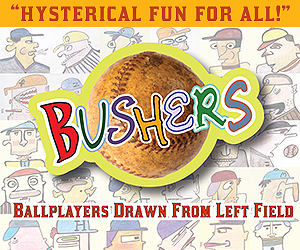The Yearly Reader
Leaders and Honors, 1927
Our list of baseball’s top 10 hitters and pitchers in both the American League and National League for the 1927 baseball season, as well as the awards and honors given to the game’s top achievers of the year.
The National League’s Top 10 Hitters, 1927
Bold type in brick red indicates league leader.
1. Rogers Hornsby, New York
Key Numbers: 155 games, .361 average, 133 runs, 205 hits, 26 home runs, 125 RBIs, 86 walks, .448 on-base percentage, .586 slugging percentage.
The Rajah returned to Hall-of-Fame form in a one-year stint with the Giants; he even managed 33 games while John McGraw dealt with health issues, winning 22 of them.
2. Paul Waner, Pittsburgh
Key Numbers: 155 games, .380 average, 114 runs, 237 hits, 42 doubles, 18 triples, 131 RBIs.
After being deprived of the 1926 batting title because of lax eligibility rules, Waner officially copped his first of three such crowns and set a Pirates season record for hits.
3. Hack Wilson, Chicago
Key Numbers: .318 average, 119 runs, 30 doubles, 12 triples, 30 home runs, 129 RBIs, 71 walks, 70 strikeouts.
Wilson managed to secure co-ownership of the NL home run title (along with the Phillies’ Cy Williams) by going deep in his penultimate at-bat of the season.
4. Bill Terry, New York
Key Numbers: .326 average, 101 runs, 189 hits, 32 doubles, 13 triples, 20 home runs, 121 RBIs.
For the first of six straight years, Terry managed to score and knock in 100 runs each.
5. Frankie Frisch, St. Louis
Key Numbers: .337 average, 112 runs, 208 hits, 31 doubles, 11 triples, 48 stolen bases.
In his first year with the Cardinals after being dealt from the Giants for Hornsby, Frisch rarely skipped a beat while feeling much more at peace after bashing heads with New York manager John McGraw.
6. Jim Bottomley, St. Louis
Key Numbers: .303 average, 31 doubles, 15 triples, 19 home runs, 124 RBIs, 74 walks.
With Hornsby gone, Bottomley became the chief offensive catalyst (along with Frisch) for the Cardinals.
7. Riggs Stephenson, Chicago
Key Numbers: .344 average, 101 runs, 199 hits, 46 doubles, 9 triples, 65 walks.
The Cubs gave the all-hit, no-throw outfielder—a former quarterback at Alabama who suffered a major shoulder injury—a chance to play every day; his bat easily made up for his throwing deficiencies.
8. George Harper, New York
Key Numbers: .331 average, 16 home runs, 87 RBIs, 84 walks.
After putting up strong numbers for the Phillies the previous three seasons, Harper proved in his first year at New York that Philadelphia’s bandboxed Baker Bowl wasn’t the reason.
9. Pie Traynor, Pittsburgh
Key Numbers: .342 average, 93 runs, 196 hits, 32 doubles, 9 triples, 106 RBIs.
The stellar third baseman was quite the road warrior, batting nearly .400 away from Forbes Field.
10. Cy Williams, Philadelphia
Key Numbers: .274 average, 86 runs, 30 home runs, 98 RBIs, 61 walks, 9 hit-by-pitches.
At the age of 39, the veteran slugger led (or co-led) the NL for the fourth time—with exactly half of his blasts recorded at snug Baker Bowl—and he became the oldest National Leaguer ever to hit for the cycle.
The American League’s Top 10 Hitters, 1927
1. Lou Gehrig, New York
Key Numbers: 155 games, .373 average, 149 runs, 218 hits, 52 doubles, 18 triples, 47 home runs, 173 RBIs, 109 walks.
Exploding into superstardom on a par with teammate Babe Ruth, Gehrig enjoyed the first of five seasons in which he averaged at least one RBI per game.
2. Babe Ruth, New York
Key Numbers: .356 average, 158 runs, 192 hits, 60 home runs, 164 RBIs, 137 walks, 89 strikeouts, .486 on-base percentage, .772 slugging percentage.
After being granted an astronomical $70,000 salary, Babe Ruth repaid the Yankees with a heavenly performance.
3. Harry Heilmann, Detroit
Key Numbers: .398 average, 106 runs, 201 hits, 50 doubles, 9 triples, 14 home runs, 120 RBIs, 72 walks.
Heilmann’s fourth batting title—all consecutively in odd years—was his last; it was also the 15th won by a Detroit player in 21 years, not including Ty Cobb’s controversial runner-up performance to Nap Lajoie in 1910.
4. Al Simmons, Philadelphia
Key Numbers: 105 games, .392 average, 89 runs, 36 doubles, 11 triples, 15 home runs, 108 RBIs.
Bucketfoot Al flirted with the .400 mark into July, but a groin injury clipped seven weeks off his season and stunted the momentum.
5. Goose Goslin, Washington
Key Numbers: .334 average, 96 runs, 194 hits, 37 doubles, 15 triples, 13 home runs, 120 RBIs, 21 stolen bases.
A year after getting shut out of his own park (Griffith Stadium) with no homers while hitting 17 on the road, Goslin managed a slim majority (7 of 13) at home.
6. Ty Cobb, Philadelphia
Key Numbers: 133 games, .357 average, 104 runs, 32 doubles, 7 triples, 93 RBIs, 67 walks, 22 stolen bases, 16 caught stealing.
Showing he had plenty to give even after surpassing his 40th birthday, Cobb had the highest season average ever by a post-40 player and, appropriately, collected his 4,000th career hit against his old team at Detroit.
7. Bob Fothergill, Detroit
Key Numbers: .359 average, 93 runs, 189 hits, 38 doubles, 9 triples, 9 home runs, 114 RBIs.
At 5’11 and 230 pounds—that’s a conservative estimate—Fothergill was another one of those talented hitters whose terrible outfielding defense would have made him an early lobbyist for the designated hitter.
8. Earle Combs, New York
Key Numbers: .356 average, 648 at-bats, 137 runs, 231 hits, 36 doubles, 23 triples.
The Yankees’ lead-off spark set a franchise record in triples; only Dale Mitchell (in 1949) and Curtis Granderson (in 2007) would equal this total among American Leaguers in years to come.
9. Bob Meusel, New York
Key Numbers: .337 average, 47 doubles, 9 triples, 8 home runs, 103 RBIs, 24 stolen bases.
Despite missing much of June to injury, Meusel still led the Yankees in steals and was one of four team members to surpass 100 RBIs.
10. Tony Lazzeri, New York
Key Numbers: .309 average, 18 home runs, 102 RBIs, 69 walks, 22 stolen bases.
You might have been expecting Babe Ruth to be the answer to this question: Who was the first Yankee to hit three homers in a regular season game? Lazzeri supplies the stumper answer, on June 8.
The National League’s Top 10 Pitchers, 1927
1. Pete Alexander, St. Louis
Key Numbers: 2.52 ERA, 21 wins, 10 losses, .677 win percentage, 268 innings, 38 walks.
Turning 40 did little to blunt Alexander’s momentum carried over from a heroic 1926 World Series, scoring his ninth and final season winning 20 or more games.
2. Jesse Haines, St. Louis
Key Numbers: 2.72 ERA, 24 wins, 10 losses, .706 win percentage, 300.2 innings, 25 complete games, 6 shutouts.
Relying more exclusively on the knuckler—which he literally gripped with his knuckles—Haines was the last player purchased (in 1919) by the Cardinals from another club until 1944, and thus well worth the $10,000 cost.
3. Ray Kremer, Pittsburgh
Key Numbers: 2.47 ERA, 19 wins, 8 losses, .704 win percentage, 25 complete games.
For the second straight year, Kremer was at his hottest late, winning his final eight decisions to help secure his second straight ERA title.
4. Red Lucas, Cincinnati
Key Numbers: 3.38 ERA, 18 wins, 11 losses, 39 walks.
Living the brand as a guy named Red playing for the Reds, Lucas emerged from the bullpen to solidify his standing as an excellent rotation piece—and missed a no-hitter on July 22 when the only hit went through the legs of second baseman Hughie Critz. (The official game scorer denied a virtual begging from both teams to change the ruling to an error.)
5. Dazzy Vance, Brooklyn
Key Numbers: 2.70 ERA, 16 wins, 15 losses, 273.1 innings, 25 complete games, 184 strikeouts, .239 opposing batting average.
After a series of misfortunate incidents the year before, Vance returned to form and led a Brooklyn team that paced the NL in team ERA (3.36) despite finishing 65-88.
6. Carmen Hill, Pittsburgh
Key Numbers: 3.24 ERA, 22 wins, 11 losses, .667 win percentage, 43 appearances, 277.2 innings.
After six attempts to kick his major league career into gear over a 12-year period, Carmen Hill finally went into overdrive by winning nearly half of his 10-year career total.
7. Charlie Root, Chicago
Key Numbers: 3.76 ERA, 26 wins, 15 losses, 48 appearances, 36 starts, 309 innings, 117 walks.
Effective support (six runs per game) vested the Chicago workhorse with a prodigious number of wins despite having the worst ERA among Cubs starters.
8. Lee Meadows, Pittsburgh
Key Numbers: 3.40 ERA, 19 wins, 10 losses, 38 starts, 25 complete games, 299.1 innings.
For the second straight year, Meadows matched teammate Ray Kremer in leading the Pirates in wins.
9. Dutch Ulrich, Philadelphia
Key Numbers: 3.17 ERA, 8 wins, 11 losses.
The latest anomaly of an unknown making Baker Bowl look expansive, with a 1.92 ERA over 17 appearances at home. Ulrich might had made for bigger fame, but he succumbed to pneumonia two years later at age 30.
10. Jesse Petty, Brooklyn
Key Numbers: 2.98 ERA, 13 wins, 18 losses, 42 appearances, 271.2 innings, 53 walks.
The hard-luck southpaw failed to get above the .500 mark again despite a second straight sub-3.00 ERA campaign.
The American League’s Top 10 Pitchers, 1927
1. Wilcy Moore, New York
Key Numbers: 2.28 ERA, 19 wins, 7 losses, .731 win percentage, 50 appearances, 12 starts, 13 saves, .234 opposing batting average.
After going 30-4 for Class-B Greenville in the Sally League in 1926, Moore hardly wilted with an upgrade in competition.
2. Ted Lyons, Chicago
Key Numbers: 2.84 ERA, 22 wins, 14 losses, 307.2 innings, 30 complete games.
After racking up twice as many walks as strikeouts in 1926, Lyons reined in his control and displayed his most dominant set of numbers over his 21-year career.
3. Waite Hoyt, New York
Key Numbers: 2.63 ERA, 22 wins, 7 losses, .759 win percentage, 256.1 innings, 23 complete games.
In his seventh year with the Yankees, Hoyt became a 20-game winner for the first time. Average support of 6.7 runs per start certainly helped.
4. Urban Shocker, New York
Key Numbers: 2.84 ERA, 18 wins, 6 losses, .750 win percentage, 41 walks.
While dealing with heart issues that would take his life the following year, the 37-year-old Shocker arguably had his most efficient year on the mound.
5. Herb Pennock, New York
Key Numbers: 3.00 ERA, 19 wins, 8 losses, .704 win percentage.
But of course, another Yankee—what else would you expect in 1927? Pennock was relatively preserved throughout the year, allowing him to shine in the World Series.
6. Tommy Thomas, Chicago
Key Numbers: 2.98 ERA, 19 wins, 16 losses, 40 appearances, 36 starts, 307.2 innings, 24 complete games.
The White Sox kept hoping that Thomas, a former 30-game winner for the minor league Baltimore Orioles in 1925, would be a second Lefty Grove. For the time being, it looked promising; among other things, he co-led the AL in innings pitched along with teammate Ted Lyons.
7. Lefty Grove, Philadelphia
Key Numbers: 3.19 ERA, 20 wins, 13 losses, 9 saves, 51 appearances, 262.1 innings, 174 strikeouts.
In reaching 20 victories for the first time, Grove certainly qualified for the best pitching performance of the year, producing the lone shutout of the 1927 Yankees. (It would be his only blanking of the season.)
8. Garland Braxton, Washington
Key Numbers: 2.95 ERA, 10 saves, 58 appearances.
The former Yankee came to Washington and shared co-closing duties with Firpo Marberry, taking on more of the load late in the season.
9. Hod Lisenbee, Washington
Key Numbers: 3.00 ERA, 12 wins, 7 losses, 22 saves, 64 appearances, 5 starts.
With aging Walter Johnson and Stan Coveleski quickly immersing into a Big Fade, the 28-year-old rookie saved his best for first, defeating the almighty Yankees five times; over seven more seasons in the majors, he would rack up only a 19-49 record.
10. Bump Hadley, Washington
Key Numbers: 2.85 ERA, 14 wins, 6 losses, .700 win percentage.
Lisenbee wasn’t the only rookie making waves in D.C., as Hadley began his career with a personal-best ERA—and would have a more furtive lifespan than Lisenbee.

